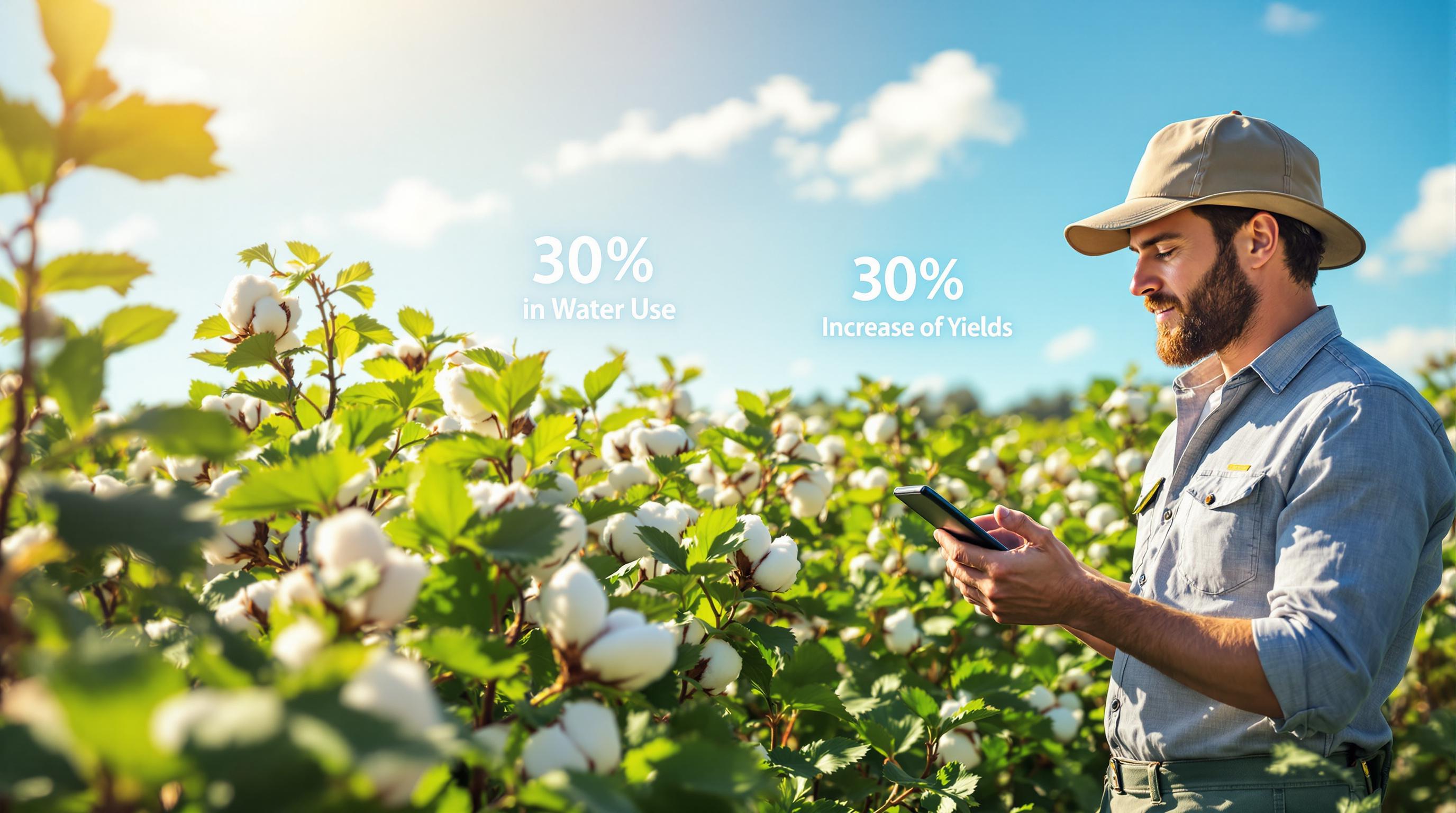The U.S. Farm Bill plays a critical role in supporting cotton producers by offering financial tools to manage market risks and production challenges. Key provisions include:
- Subsidy Programs: Options like Price Loss Coverage (PLC), Agricultural Risk Coverage (ARC), and the Stacked Income Protection Plan (STAX) help stabilize income and mitigate price or revenue fluctuations.
- Crop Insurance: Programs like Multi-Peril Crop Insurance (MPCI), Supplemental Coverage Option (SCO), and Whole-Farm Revenue Protection (WFRP) protect against yield losses and revenue risks.
- Commodity Program Updates: Adjustments to payment structures, eligibility rules, and program flexibility ensure better alignment with market conditions.
- Domestic Processing Support: Financial assistance for U.S. textile mills strengthens the connection between growers and processors.
These programs provide cotton growers with resources to navigate economic and environmental uncertainties while reinforcing the domestic cotton supply chain.
Seed Cotton PLC/ARC-CO Provisions and Examples
Federal Subsidy Programs for Cotton
Expanding on the role of the Farm Bill in supporting cotton production, this section dives into the federal subsidy programs that provide financial stability for cotton farmers. These programs act as crucial safety nets, helping farmers navigate income fluctuations caused by unpredictable market prices or adverse weather conditions.
Current Subsidy Program Options
Cotton farmers have access to several key subsidy programs, each designed to address different aspects of income protection. Here’s a breakdown of the primary options:
- Price Loss Coverage (PLC): This program steps in when the national average market price for cotton drops below a predetermined reference price. It focuses solely on price protection, offering payments regardless of how much cotton a farm produces.
- Agricultural Risk Coverage (ARC): ARC focuses on revenue protection and is offered at two levels: county and individual farm. The ARC-County option triggers payments when county-level revenue falls below a set benchmark. Meanwhile, ARC-Individual activates payments based on the revenue performance of a specific farm.
- Stacked Income Protection Plan (STAX): Designed specifically for cotton producers, STAX is an area-based insurance program that covers shallow revenue losses. It works alongside other insurance policies, filling the gap between a chosen deductible and the trigger point of another policy. This added layer of protection allows farmers to customize their coverage.
To qualify for these programs, farmers must maintain base acres, follow conservation practices, and meet adjusted gross income limits.
Recent Policy Changes and Market Factors
In recent years, subsidy programs have been fine-tuned to better align with evolving market conditions and trade challenges. These updates aim to balance financial support for farmers with fiscal responsibility.
One major improvement is the adjustment of payment calculations to better reflect current economic realities. For instance, the reference price in the PLC program now accounts for inflation and rising production costs. Similarly, ARC benchmarks have been updated to include more recent production data, ensuring revenue projections are more accurate.
Trade disruptions have also led to the introduction of flexible support mechanisms. New provisions allow for quicker payment processing during times of significant market stress, ensuring farmers receive timely assistance when they need it most.
Another notable change is the stronger emphasis on conservation. Subsidy eligibility now requires farmers to implement conservation plans on vulnerable lands and prohibits the conversion of wetlands. These measures tie financial support to responsible land management practices.
Subsidy Program Comparison
To help farmers choose the best option for their needs, here’s a comparison of the main subsidy programs:
| Program | Coverage Type | Payment Trigger | Coverage Level | Premium Cost |
|---|---|---|---|---|
| PLC | Price protection | National average price falls below reference price | Set reference price | No premium required |
| ARC-County | Revenue protection | County revenue falls below benchmark threshold | Percentage of benchmark revenue | No premium required |
| ARC-Individual | Revenue protection | Individual farm revenue falls below benchmark threshold | Percentage of benchmark revenue | No premium required |
| STAX | Area protection | Area revenue falls below chosen coverage level | Flexible coverage based on producer selection | Premium required (subsidized) |
The right program depends largely on a farm’s unique risk profile and local conditions. For example, farmers in areas with stable yields might prefer ARC-County, while those dealing with more unpredictable conditions may lean toward ARC-Individual or PLC. STAX offers additional flexibility, letting producers tailor coverage to work alongside other programs.
Each program also comes with payment limits to ensure that funds are distributed fairly and program costs remain manageable. These adjustments pave the way for broader discussions on agricultural risk management strategies in the following sections.
Crop Insurance Options for Cotton Producers
Crop insurance plays a crucial role in protecting cotton producers from financial losses caused by unpredictable weather and market fluctuations. Here's an overview of the key insurance programs designed to provide that safety net.
Main Insurance Programs
The Farm Bill includes several crop insurance programs tailored specifically for cotton growers:
- Multi-Peril Crop Insurance (MPCI): This program shields farmers from yield losses caused by extreme weather events like drought, hail, or heavy rain. It guarantees a portion of the farm's average yields, offering a reliable fallback during challenging seasons.
- Supplemental Coverage Option (SCO): SCO adds an extra layer of protection by covering part of the deductible on primary crop insurance policies. This reduces out-of-pocket costs for farmers, particularly during widespread losses at the county level.
- Whole-Farm Revenue Protection (WFRP): Instead of focusing on specific crops, WFRP provides coverage for the entire farm's revenue, giving diversified operations broader financial security.
- Actual Production History (APH): Coverage levels and premium rates under APH are determined by historical yield records, ensuring that the insurance reflects the farm's performance over time.
These programs also include quality adjustments, which compensate farmers not just for yield losses but also for any decline in crop quality.
Premium Subsidy Updates
Recent updates to premium subsidies have made crop insurance more affordable for cotton producers. Federal subsidies cover a large portion of premiums, and additional discounts are available for beginning farmers. In areas frequently hit by severe weather, the subsidy structure offers increased assistance, ensuring farmers in these regions can access adequate protection. Enhanced coverage for prevented planting also helps farmers manage fixed costs when adverse conditions delay or prevent planting altogether.
Financial Impact for Farmers
Quick claim adjustments and prompt payments are critical for farmers facing planting delays or crop losses. These timely responses help maintain cash flow, reduce financial strain, and allow farmers to plan for future production with greater confidence. By combining federal subsidies with robust insurance options, cotton producers gain a comprehensive financial safety net that helps them navigate both immediate challenges and long-term risks.
sbb-itb-0e617ca
Commodity Program Updates and Eligibility Changes
The latest farm bill introduces updated commodity program provisions that can significantly impact the financial planning and decision-making of cotton producers. These updates bring changes to payment structures and program selection options, making it crucial for producers to stay informed about new rules and opportunities.
Payment Limits and Eligibility Rules
Under the revised farm bill, payments for Agriculture Risk Coverage (ARC) and Price Loss Coverage (PLC) programs are issued in the fall of the year following the crop year. For example, payments for the 2023 crop year will be distributed in fall 2024. This predictable schedule aids in planning finances. The payment structure remains the same for both programs, with seed cotton included as a covered commodity. However, eligibility is influenced by the farm's structure, such as whether it operates as an LLC or partnership. Producers are encouraged to consult their local Farm Service Agency (FSA) office to ensure compliance with the latest guidelines.
Base Acre Allocation and Program Selection
Cotton producers have the flexibility to choose commodity programs that best fit their risk management strategies. They can enroll in ARC-County (ARC-CO) or PLC for crop-specific coverage or opt for ARC-Individual (ARC-IC) to cover the entire farm. While changing program elections is optional, producers must sign a contract annually to confirm their selection. Missing the enrollment deadline - such as March 15, 2024, for the 2024 crop year - means the previous year's program choice will carry over.
The choice between ARC and PLC is critical for managing economic risks, and producers can use online decision-making tools provided by universities to guide their selection. Importantly, the 2018 Farm Bill, which established these programs, has been extended through September 30, 2024, ensuring their availability for the upcoming crop year. Additionally, these program choices can influence coordination with crop insurance, further underscoring their importance in financial planning.
Payment Timing and Program Flexibility
Understanding how commodity programs interact with crop insurance is essential for effective financial management. For instance, farms enrolled in PLC are eligible to purchase the Supplemental Coverage Option (SCO), while those enrolled in ARC are not eligible for SCO on their planted acres. Similarly, upland cotton farmers with seed cotton base acres enrolled in ARC or PLC cannot use the stacked income protection plan (STAX) for their planted acres.
The annual enrollment requirement means that even producers who wish to stick with their current program must contact their local FSA office and sign a contract each year. The consistent timing of fall payments provides a reliable framework for cash flow planning, especially during harvest and for preparing the next planting cycle.
Support for Domestic Cotton Processing
The Farm Bill doesn’t stop at supporting cotton production - it also focuses on strengthening the processing stage to ensure the entire cotton value chain thrives. By connecting growers, processors, and textile mills, it aims to bolster domestic cotton processing and create a more cohesive, efficient system. Let’s break down how this financial support impacts textile mills and the broader cotton industry.
Economic Assistance for Textile Mills
To give U.S. textile mills a competitive edge, the Farm Bill ensures they have access to high-quality domestic cotton at competitive prices. This helps offset the cost challenges posed by imported cotton and encourages greater reliance on homegrown resources.
Benefits for Cotton Growers and Processors
These measures don’t just help mills - they also bring stability to cotton prices and fuel economic growth in rural areas. By adding value within cotton-producing regions, the Farm Bill strengthens the entire network, including ginning operations, which play a key role in the processing chain. If you’re looking for detailed information on cotton gin locations, check out cottongins.org.
This comprehensive approach ties together production, processing, and textile manufacturing, ensuring the domestic cotton industry remains strong and interconnected.
Conclusion: Cotton Policy and Industry Resources
The cotton provisions in the Farm Bill are designed to support every aspect of the cotton industry, from the initial planting stages to the final processing. This support is especially critical now, as production costs have surged by 25% since 2018, with an additional $200 per acre in expenses and fertilizer prices more than doubling.
Understanding federal programs goes beyond accessing subsidies; it’s about ensuring long-term financial stability and managing the risks that come with cotton production. The updated Farm Bill provisions offer multi-year predictability, reducing dependence on last-minute emergency aid. This stability gives farmers and lenders the clarity they need for effective financial planning, while also reinforcing production and market reliability. Such foresight allows producers to adjust as policies continue to evolve.
To fully benefit from these programs, producers need to stay informed about changes in eligibility requirements and payment schedules. Those who remain engaged with policy updates and actively participate in public discussions are better positioned to maximize the available support.
In addition to federal programs, reliable industry resources play a pivotal role in strengthening operations. Tools like cottongins.org offer comprehensive directories to help farmers connect with processors, locate cotton gins, and build relationships across the cotton value chain. These resources, combined with federal support, create a solid foundation for growth.
FAQs
How do programs like PLC, ARC, and STAX help cotton farmers reduce financial risks?
Programs like Price Loss Coverage (PLC), Agriculture Risk Coverage (ARC), and the Stacked Income Protection Plan (STAX) are crucial tools for cotton farmers facing the ups and downs of market conditions.
- PLC steps in when cotton prices drop below a set benchmark, offering payments to help farmers offset those losses.
- ARC provides financial support if a farm's revenue falls below a guaranteed level, calculated using historical averages. This helps safeguard farmers against unexpected revenue dips.
- STAX addresses income fluctuations by covering revenue losses at the county level, with cotton lint futures prices serving as the foundation for calculations.
By working together, these programs create a financial safety net that helps cotton farmers navigate the uncertainties of price swings and revenue challenges, offering a more stable foundation for their businesses.
What updates have been made to cotton crop insurance programs, and how do they affect cost and coverage for farmers?
Recent changes to cotton crop insurance programs have brought about higher subsidy rates, with some coverage levels now benefiting from subsidies as high as 80%. The goal? To ease the financial burden on farmers by reducing their out-of-pocket costs.
On top of that, the USDA's Risk Management Agency has rolled out updates that expand coverage options and customize policies to better align with the specific needs of cotton producers. These adjustments provide farmers with stronger tools to manage risks, helping them maintain financial stability even when faced with unpredictable challenges.
How does the Farm Bill support cotton growers and U.S. textile mills?
The Farm Bill plays a key role in bolstering the cotton industry, offering financial support to both cotton growers and U.S. textile mills. By increasing payment rates for cotton utilized in textile production, it provides much-needed economic relief to mills. At the same time, it raises marketing assistance loan rates, which helps growers handle revenue challenges and adapt to market shifts.
Together, these measures aim to reinforce the domestic cotton sector, promoting growth for farmers and aiding the long-term success of textile mills across the country.


